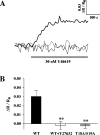Real-time imaging of myosin II regulatory light-chain phosphorylation using a new protein biosensor
- PMID: 15362955
- PMCID: PMC1134733
- DOI: 10.1042/BJ20040778
Real-time imaging of myosin II regulatory light-chain phosphorylation using a new protein biosensor
Abstract
Phosphorylation of the RMLC (regulatory myosin light chain) regulates the activity of myosin II, which is critically involved in the motility of both muscle and non-muscle cells. There are both Ca2+-dependent and -independent pathways for RMLC phosphorylation in smooth-muscle cells, and the latter pathway is often involved in an abnormal contractility in pathological states such as asthma and hypertension. Therefore pharmacological interventions of RMLC phosphorylation may have a therapeutic value. In the present study, we developed a new genetically encoded biosensor, termed CRCit (ECFP-RMLC-Citrine, where ECFP is enhanced cyan fluorescent protein), that detects RMLC phosphorylation using fluorescence resonance energy transfer between two variants of the green fluorescent protein fused to both the N- and C-termini of RMLC. When expressed in primary cultured vascular smooth-muscle cells, CRCit detected the Ca2+-dependent RMLC phosphorylation with a high spatiotemporal resolution. Furthermore, we could specifically assay the agonist-induced Ca2+-independent phosphorylation of RMLC when Ca2+ signalling in cells expressing CRCit was suppressed. Thus CRCit may also be used for the high throughput screening of compounds that inhibit abnormal smooth-muscle contraction.
Figures




References
-
- De Lozanne A., Spudich J. A. Disruption of the Dictyostelium myosin heavy chain gene by homologous recombination. Science. 1987;236:1086–1091. - PubMed
-
- Horwitz A. R., Parsons J. T. Cell migration–movin' on. Science. 1999;286:1102–1103. - PubMed
-
- Wylie S. R., Chantler P. D. Separate but linked functions of conventional myosins modulate adhesion and neurite outgrowth. Nat. Cell Biol. 2001;3:88–92. - PubMed
-
- Somlyo A. P., Somlyo A. V. Signal transduction and regulation in smooth muscle. Nature (London) 1994;372:231–236. - PubMed
Publication types
MeSH terms
Substances
LinkOut - more resources
Full Text Sources
Miscellaneous

